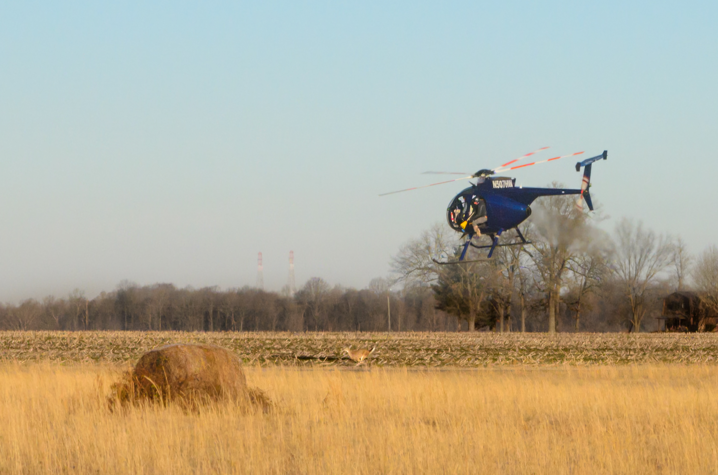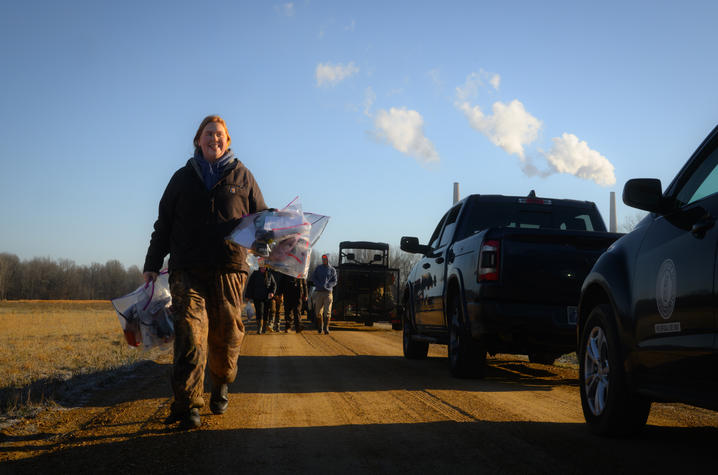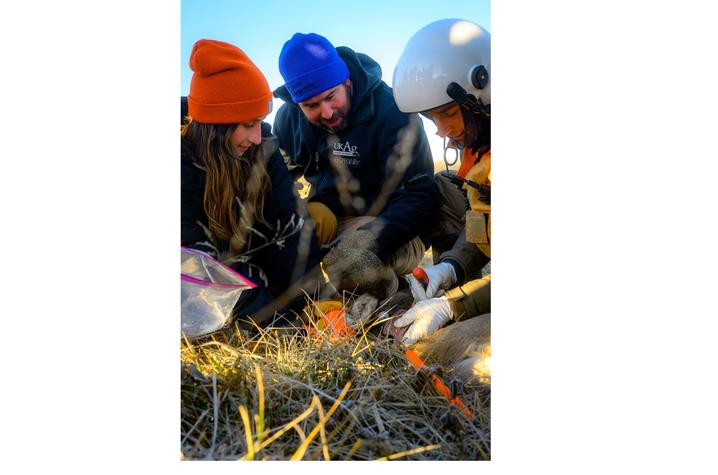Preserving Kentucky’s deer: UK, Kentucky Fish & Wildlife study Chronic Wasting Disease
LEXINGTON, Ky. (Nov. 12, 2025) — Like thousands of Kentuckians, a team from the University of Kentucky Martin-Gatton College of Agriculture, Food and Environment (CAFE) and the Kentucky Department of Fish & Wildlife Resources (KDFWR) is on the lookout for deer. But once caught by researchers, these deer are allowed to return to their Western Kentucky populations — with a GPS collar to help understand movement patterns and predict the potential spread of Chronic Wasting Disease (CWD).
CWD is a brain disease that affects deer and other cervids. There is no cure, and the disease is always fatal — though deer can be infected for years and spread the infection through direct contact or environmental contamination before showing symptoms.
Affecting neurological function, symptoms include decreased body condition, which is where the name “wasting” comes from, as well as behavioral changes toward people and other deer, confusion or nervousness, and repetitive movements.
As of Oct. 29, KDFWR has confirmed two cases of CWD in wild deer in Kentucky, including one in the 2025 hunting season. Tracking how deer move can help researchers understand how CWD might spread, which shapes response plans.
Martin-Gatton CAFE Department of Forestry and Natural Resources (FNR) faculty John Cox, Ph.D., professor of wildlife and conservation biology, and Matthew Springer, Ph.D. associate extension professor of wildlife management, are the co-principal investigators for the UK and KDFWR project. This work is supported by a $226,000 award from KDFWR.
“We’re working to come up with surveillance protocols and management strategies to help preserve the resource that white-tailed deer are in our state, as well as the potential for public health knowledge with a disease that’s not necessarily an immediate threat but could be in the future,” Springer said.
Studying deer dispersal patterns
Capturing a deer takes planning, patience and — sometimes — a helicopter.
Over the course of the two-year study, 120 GPS collars will be deployed. Capture methods include a combination of helicopter net-gunning, clover traps and drop nets to track deer movements.
“There’s a lot of patience involved — a lot like hunting,” said Haley Taylor, an FNR graduate student. “Sometimes you get something, sometimes you don’t.”
Now a UK graduate research assistant, Taylor began this project, which is her master’s thesis, while working for KDFWR.
“I’m originally from Kentucky, and I love it here, and I’ve gotten the privilege to work at every corner of the state,” Taylor said. “The diverse landscape that we have in the state and the ability to do all these different things in one area is amazing.”
A team from UK and KDFWR gathered in February in Western Kentucky for a multiday operation.
During a helicopter capture, the helicopter hovers over a forested area, “rustling” up the deer so researchers can see them. When it’s close enough, the helicopter deploys a “rocket” net that covers the deer.
For a drop net capture, the team chooses a location and sets up a net, with a line attached to a trigger pole. Later, on-site researchers use thermal cameras to watch and pull the line when deer move under the net.
No matter how the deer is captured, a member of the research team is prepared with a bag that includes a collar, sampling materials and a data sheet.
“We’ve done a lot of the work on the front end with the help of our technicians and other students,” said Taylor, who manages the collection and analysis.
The researcher follows an immobilization protocol for the deer, including checking vitals and taking a blood sample. Then the researcher puts a thin collar on the deer and releases it back into the population unharmed, with minimal disruption to its normal life.
Researchers then track deer movement in relation to varying landscapes and populations, allowing them to study dispersal patterns. Insights from this research help predict both CWD spread and response to weather events.
A partnership that prepares future professionals
Through this and other projects with KDWFR, UK undergraduate and graduate students get hands-on experience with professional biologists that complements classroom learning.
“Actually seeing it in practice done by the state agency that’s in charge of managing this resource is something that’s really hard to emulate in a classroom,” Springer said. “We're lucky enough that the state agency recognizes that.”
Joe McDermott, now the deer program coordinator for KDFWR, earned his master’s degree in forestry from UK.
“We’ve got a great partnership with UK, and we’re trying to continue to build on that and get some good work done,” McDermott said.
As a manager for more than 10 years, McDermott has hired for many positions. His number one piece of advice for students who want to be biologists or in related roles is to get out and accumulate experience.
“It’s a fun job. I don’t generally hate Mondays,” McDermott said. “But at the same time, it’s a very competitive field, and it’s a pretty intense field. If there’s anything you can do to set yourself apart from others and help you get going, that is going to be beneficial for you.”
Thanks to networking and leadership opportunities throughout this project, Taylor said she is ready for what comes next.
“I feel extremely prepared,” she said.
The CWD project will continue through at least 2027.
Find more UK and KDFWR resources about Chronic Wasting Disease at https://forestry.mgcafe.uky.edu/cwd.



As the state’s flagship, land-grant institution, the University of Kentucky exists to advance the Commonwealth. We do that by preparing the next generation of leaders — placing students at the heart of everything we do — and transforming the lives of Kentuckians through education, research and creative work, service and health care. We pride ourselves on being a catalyst for breakthroughs and a force for healing, a place where ingenuity unfolds. It's all made possible by our people — visionaries, disruptors and pioneers — who make up 200 academic programs, a $476.5 million research and development enterprise and a world-class medical center, all on one campus.




